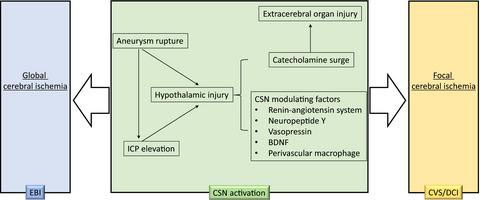当前位置:
X-MOL 学术
›
J. Neurochem.
›
论文详情
Our official English website, www.x-mol.net, welcomes your
feedback! (Note: you will need to create a separate account there.)
Central sympathetic nerve activation in subarachnoid hemorrhage
Journal of Neurochemistry ( IF 4.2 ) Pub Date : 2021-09-15 , DOI: 10.1111/jnc.15511 Yu Hasegawa 1, 2 , Hiroki Uchikawa 3 , Sosho Kajiwara 2 , Motohiro Morioka 2
Journal of Neurochemistry ( IF 4.2 ) Pub Date : 2021-09-15 , DOI: 10.1111/jnc.15511 Yu Hasegawa 1, 2 , Hiroki Uchikawa 3 , Sosho Kajiwara 2 , Motohiro Morioka 2
Affiliation

|
Subarachnoid hemorrhage (SAH) is a life-threatening condition, and although its two main complications—cerebral vasospasm (CVS)/delayed cerebral ischemia (DCI) and early brain injury (EBI)—have been widely studied, prognosis has not improved over time. The sympathetic nerve (SN) system is important for the regulation of cardiovascular function and is closely associated with cerebral vessels and the regulation of cerebral blood flow and cerebrovascular function; thus, excessive SN activation leads to a rapid breakdown of homeostasis in the brain. In the hyperacute phase, patients with SAH can experience possibly lethal conditions that are thought to be associated with SN activation (catecholamine surge)-related arrhythmia, neurogenic pulmonary edema, and irreversible injury to the hypothalamus and brainstem. Although the role of the SN system in SAH has long been investigated and considerable evidence has been collected, the exact pathophysiology remains undetermined, mainly because the relationships between the SN system and SAH are complicated, and many SN-modulating factors are involved. Thus, research concerning these relationships needs to explore novel findings that correlate with the relevant concepts based on past reliable evidence. Here, we explore the role of the central SN (CSN) system in SAH pathophysiology and provide a comprehensive review of the functional CSN network; brain injury in hyperacute phase involving the CSN system; pathophysiological overlap between the CSN system and the two major SAH complications, CVS/DCI and EBI; CSN-modulating factors; and SAH-related extracerebral organ injury. Further studies are warranted to determine the specific roles of the CSN system in the brain injuries associated with SAH.
中文翻译:

蛛网膜下腔出血中枢交感神经激活
蛛网膜下腔出血 (SAH) 是一种危及生命的疾病,尽管其两种主要并发症——脑血管痉挛 (CVS)/迟发性脑缺血 (DCI) 和早期脑损伤 (EBI)——已被广泛研究,但预后并未随着时间的推移而改善. 交感神经(SN)系统对心血管功能的调节很重要,与脑血管、脑血流和脑血管功能的调节密切相关;因此,过度的 SN 激活会导致大脑内稳态的快速破坏。在超急性期,SAH 患者可能会经历被认为与 SN 激活(儿茶酚胺激增)相关的心律失常、神经源性肺水肿以及下丘脑和脑干不可逆损伤相关的致命状况。虽然长期以来对 SN 系统在 SAH 中的作用进行了研究并收集了相当多的证据,但确切的病理生理学仍未确定,这主要是因为 SN 系统与 SAH 之间的关系复杂,涉及许多 SN 调节因素。因此,关于这些关系的研究需要探索与基于过去可靠证据的相关概念相关的新发现。在这里,我们探讨了中央 SN (CSN) 系统在 SAH 病理生理学中的作用,并全面回顾了功能性 CSN 网络;涉及 CSN 系统的超急性期脑损伤;CSN 系统与两种主要 SAH 并发症 CVS/DCI 和 EBI 之间的病理生理学重叠;CSN 调节因子;和 SAH 相关的脑外器官损伤。
更新日期:2021-09-15
中文翻译:

蛛网膜下腔出血中枢交感神经激活
蛛网膜下腔出血 (SAH) 是一种危及生命的疾病,尽管其两种主要并发症——脑血管痉挛 (CVS)/迟发性脑缺血 (DCI) 和早期脑损伤 (EBI)——已被广泛研究,但预后并未随着时间的推移而改善. 交感神经(SN)系统对心血管功能的调节很重要,与脑血管、脑血流和脑血管功能的调节密切相关;因此,过度的 SN 激活会导致大脑内稳态的快速破坏。在超急性期,SAH 患者可能会经历被认为与 SN 激活(儿茶酚胺激增)相关的心律失常、神经源性肺水肿以及下丘脑和脑干不可逆损伤相关的致命状况。虽然长期以来对 SN 系统在 SAH 中的作用进行了研究并收集了相当多的证据,但确切的病理生理学仍未确定,这主要是因为 SN 系统与 SAH 之间的关系复杂,涉及许多 SN 调节因素。因此,关于这些关系的研究需要探索与基于过去可靠证据的相关概念相关的新发现。在这里,我们探讨了中央 SN (CSN) 系统在 SAH 病理生理学中的作用,并全面回顾了功能性 CSN 网络;涉及 CSN 系统的超急性期脑损伤;CSN 系统与两种主要 SAH 并发症 CVS/DCI 和 EBI 之间的病理生理学重叠;CSN 调节因子;和 SAH 相关的脑外器官损伤。











































 京公网安备 11010802027423号
京公网安备 11010802027423号